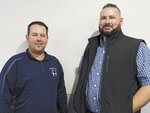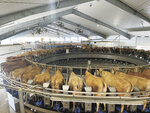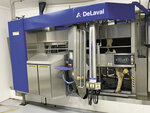


TILLAMOOK, Ore. — Derrick Josi had blueprints for a new milking facility on his refrigerator for over 10 years before building a rotary parlor in 2022. This fourth-generation farmer wished to relocate facilities to higher, drier ground after the farm spent more than a century in a flood plain.
“The rotary has been an amazing experience,” Josi said. “It is by far the best decision I ever made in my life.”
Josi milks 720 cows twice a day in a 50-stall DeLaval rotary parlor at Wilsonview Dairy near Tillamook. When starting anew, cow comfort was a top consideration for parlor design. Josi also wanted to see an increase in milk production and hoped to improve cow flow, data availability and employee comfort.
He expanded his herd of Jerseys, which are now averaging 55 pounds of milk, 5.17% butterfat and nearly 4% protein. The rotary milks 190 cows per hour — a drastic improvement in speed from the double-12 herringbone he previously milked in.
“The last cow to get on that rotary is back in the barn in less than an hour,” Josi said.
Mitch Moorlag, of Edaleen Dairy near Lynden, Washington, also built new facilities and milks 1,100 cows with 20 DeLaval robotic milking systems.
Josi and Moorlag were part of a Knowledge Nook producer panel sponsored by DeLaval, “Robots or Rotary: Considerations When Choosing Large Herd Automation,” Oct. 6 at World Dairy Expo in Madison, Wisconsin. Both dairymen shared details of their decision-making process and the successes they have experienced with their respective milking systems.
Competing for labor with other agricultural sectors as well as the landscaping and construction industries made it difficult for Moorlag to find workers. And when the state put in overtime laws for agricultural workers in 2021, Moorlag said he could not afford to pay his employees time and a half for 20 extra hours a week.
“Labor was the No. 1 reason we went with robots,” Moorlag said. “Labor retention and cost were huge factors. To have a full milking crew, we needed 11 to 12 people. It was a fairly simple decision.”
Up and running for 16 months, Moorlag has seen a 4% increase in milk production since switching to robots and is expecting to grow that number over time. Cows average 3.2 milkings per day and are sustaining peak milk longer. In addition, Moorlag has seen a noticeable drop in injuries and lameness, which he attributes to eliminating trips to and from the parlor.
Prior, Moorlag milked three times a day in a double-41 parallel installed in 1996. The parlor was starting to show its age, and in 2017, Moorlag began looking for options. He viewed rotary and parallel parlors as well as robots, but in the end, robots won out. Edaleen Dairy is a producer-handler, and another benefit of robots was that it allowed cows to be on their own time cycle, which Moorlag’s wholesale customers found attractive.
Josi also considered robots, but he found the rotary to be a better match.
“I didn’t want a midnight phone call from a robot saying my cows aren’t being milked,” Josi said. “I would’ve had to scale back on employees too and didn’t want to do that to people who had been working for me for 10 or 15 years.”
At Moorlag’s farm, a person is on-site 24 hours a day to handle maternity and other issues, but Moorlag said that midnight phone calls from the robot are few and far between.
Moorlag’s herd is 70% Holstein and 30% Jersey, and he plans to increase to 1,300 head milking in the next year.
“That will max us out on robots and stall space,” he said.
Moorlag has a mix of both guided-flow and free-flow robotic systems that animals move between depending on where a cow is at in her lactation. Once confirmed pregnant, cows go through a free-flow robot.
“The number of cows we have to go and fetch is lowering every week,” Moorlag said.
Moorlag’s nephew came on board and is handling operations and maintenance of the robots.
“He is a hands-on mechanic type who is very interested in electronics and fits in perfectly there even though he didn’t know anything about robots before,” Moorlag said.
On the cow side, Moorlag retained his four milkers who still milk fresh animals but are able to spend more time with cows and attend to matters quicker.
“Employees love the robots,” Moorlag said.
An automatic feed pusher can be found in each of Moorlag’s three barns. He also has an automatic sort gate and is planning to take lockups out of his barns. Josi’s setup also features an automatic sort gate.
“I love it because I don’t have lockups in any of my freestall barns,” Josi said.
Moorlag wanted to see more turns through and lower labor costs and has achieved both goals with robots.
Josi’s facilities helped him accomplish his goals as well, including boosting employee morale. As a result, he is seeing higher retention of better-quality employees.
“Employees are much happier, especially the milkers,” Josi said. “The parlor is so much easier on them. They’re not doing all the walking, and everything is right there.”
Josi has eight employees. Three people work in the parlor, and Josi runs an eight-hour split-shift milking with employees working a five-day, 40-hour workweek.
“I gave a pay raise to make up for lost hours,” Josi said. “I didn’t want their quality of life to go down. I wanted to make it a better quality of life. I can pay comparable to what other industries are paying, and we found that we don’t have any problems finding employees now.”
Josi’s parlor features post-dip automation, and he is thinking about putting in pre-dip automation as well. He continues to fill his parlor to capacity and has plans to build a visitor center to capitalize on agritourism.
“Robots are cool, but watching cows go onto a rotary is great for tourism,” Josi said. “People just love it.”
Moorlag is also looking to tap into tourism possibilities and added an educational room with a viewing window in one of his barns.
From the milking independence cows enjoy at Moorlag’s dairy to riding the rotary at Josi’s operation, both farmers are confident they chose the right type of milking system for their farm and herd.
Comments
No comments on this item Please log in to comment by clicking here